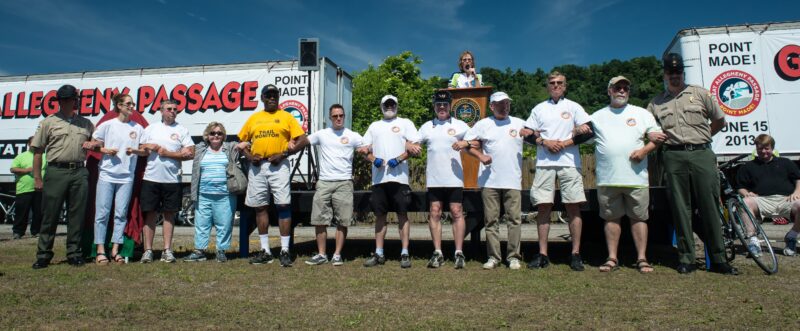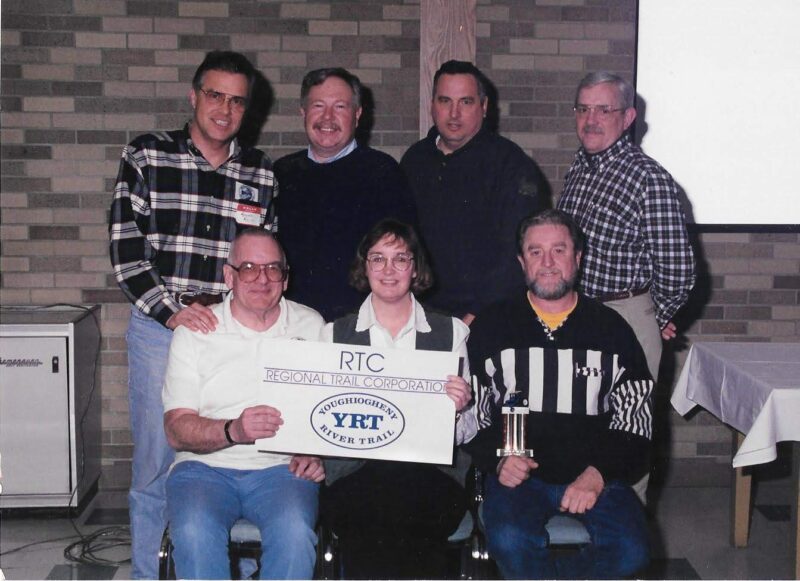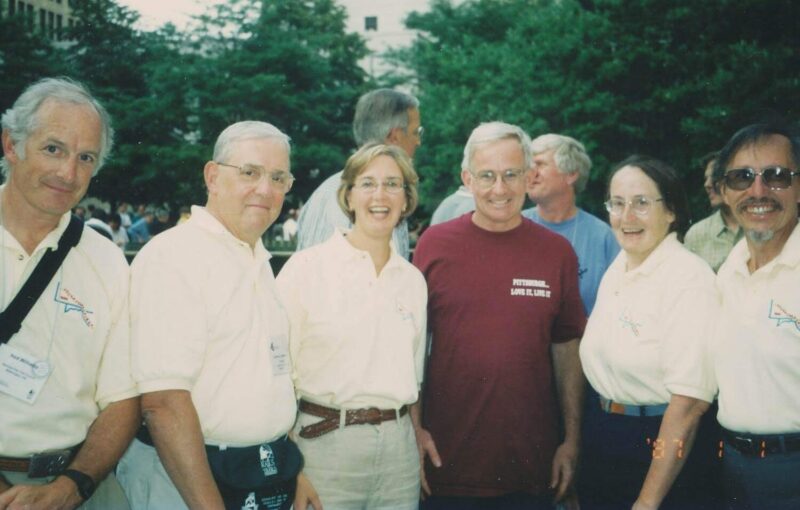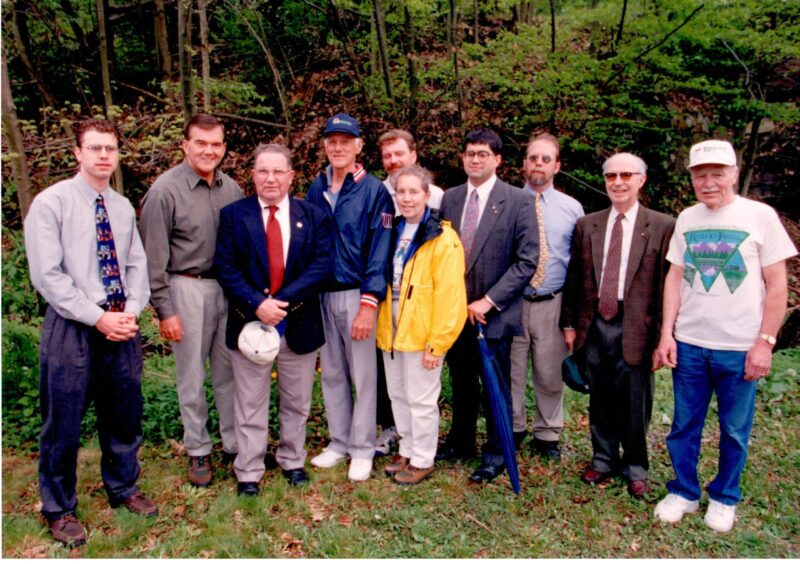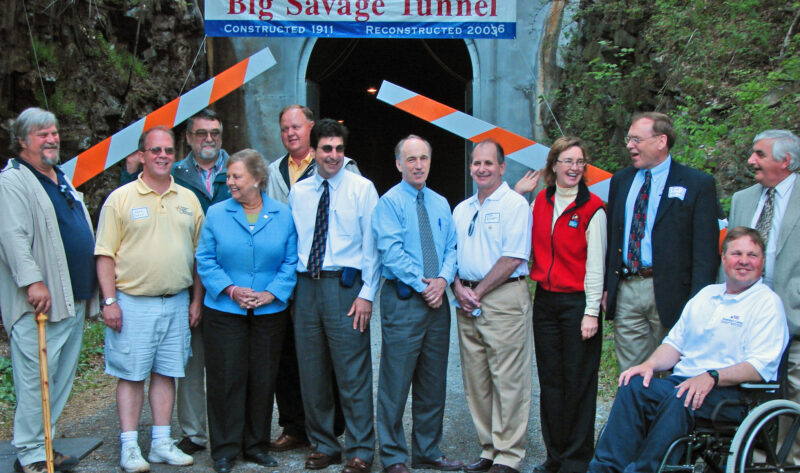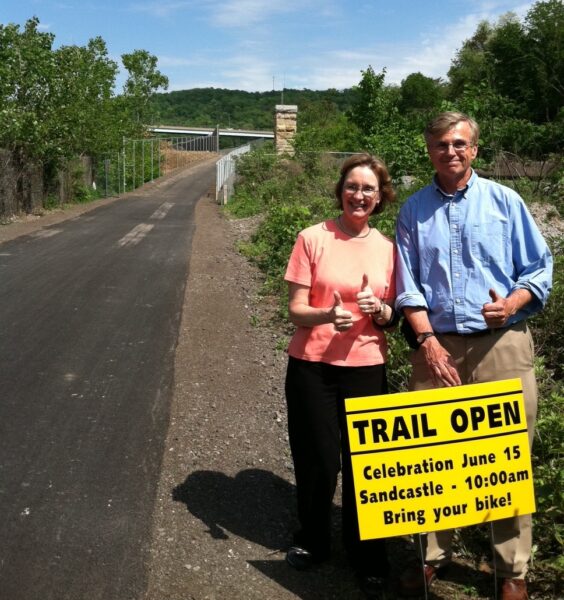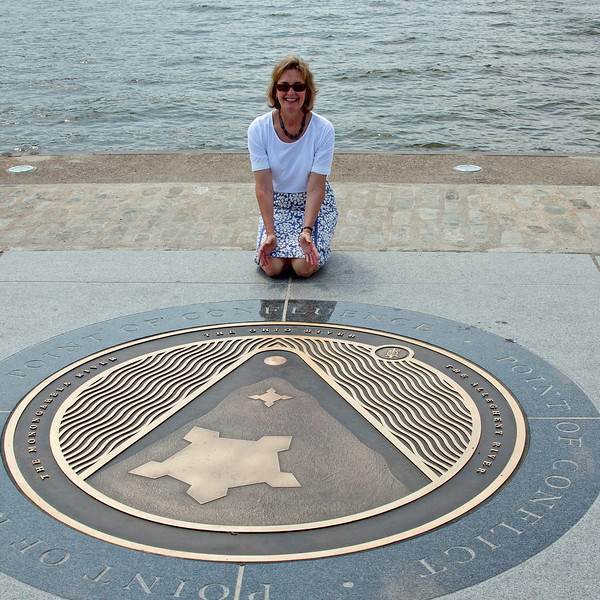Linda McKenna Boxx: The Linchpin of the GAP
The passage of the Intermodal Surface Transportation Efficiency Act (ISTEA) in 1991 marked a transformation in federal transportation policy by including funding for recreational trails.[1] Also, by 1990 U.S. railroads had abandoned over 100,000 miles of track, and railbanking legislation passed in 1983 made it easier to acquire the lengthy, relatively flat right-of-ways that were perfect for trails.[2] With such favorable conditions, enthusiastic volunteers and devoted municipal, county, and state employees were able to begin constructing many of the beautiful trail sections that now make up the Great Allegheny Passage—but completing an uninterrupted trail from Cumberland, Maryland to Point State Park in downtown Pittsburgh likely could not have happened without Linda McKenna Boxx.
“…frankly this project would not have happened if it wasn’t for Linda. She would not take “no” and she worked around every single obstacle. If there was a saint for this project, it’s Linda Boxx, pure and simple.”
~ John C. Oliver III, former Secretary of the Pennsylvania Dept. of Natural Resources, May 2005
In 1993, the Regional Trail Corporation (RTC) recognized that they had a problem—and Boxx, with her unique set of experiences, skills, and connections, was part of their solution. They were struggling to raise matching funds because the new availability of federal funding meant that every trail group was competing for foundation and corporate donations. “[W]hen we were talking to a series of different major funders, they were saying, ‘which trail group is this?’” recalls Bob Teeter of Teeter Associates, a consulting firm hired by the RTC to help with fundraising.[i] Teeter and Malcolm Sias, who was then the vice president of RTC, recognized that “we really needed to bring some people into the board that had strong ties within all the communities, within the counties, to the businesses, foundations, corporations,” and both of them knew Boxx had those ties.[ii] She was elected to the RTC board in February 1994.
Well, it was key to me, if we were going to take a real big step, we had to do it in a different kind of way. And Linda had the really right combination of things. I mean, managing a foundation is fabulous. But, she had a passion for the project. And she could work with different people and had more patience on some things that these trail people really needed. Somebody else would have come in and said, “We’re spending ten minutes on that; not two meetings.” Linda was patient enough to take the time to work with them. Because if they didn’t all come together, it could have never happened.
~ Bob Teeter transcript p.6
Boxx had connections, but she also brought valuable skills and experiences, a strong work ethic instilled by her parents, and boundless energy. Her first job out of college was as a Planning Analyst with the Pennsylvania Governor’s Office of State Planning and Development, where she learned how thoughtful planning can have a lasting, positive environmental impact. She also built relationships with colleagues who would later help facilitate the trail’s construction from Harrisburg; the “guy that was second base on our little baseball team [in the late 1970s] was the head of state parks [by the 1990s] and another fellow [on our team] was doing all the data research for the abandoned rail lines.”[1]
In 1979 she moved to Arkansas to work in Governor Bill Clinton’s first administration. After he lost his bid for a second term, Boxx returned to western Pennsylvania to work for her family’s foundations, primarily the Katherine Mabis McKenna Foundation which funded cultural and educational projects that
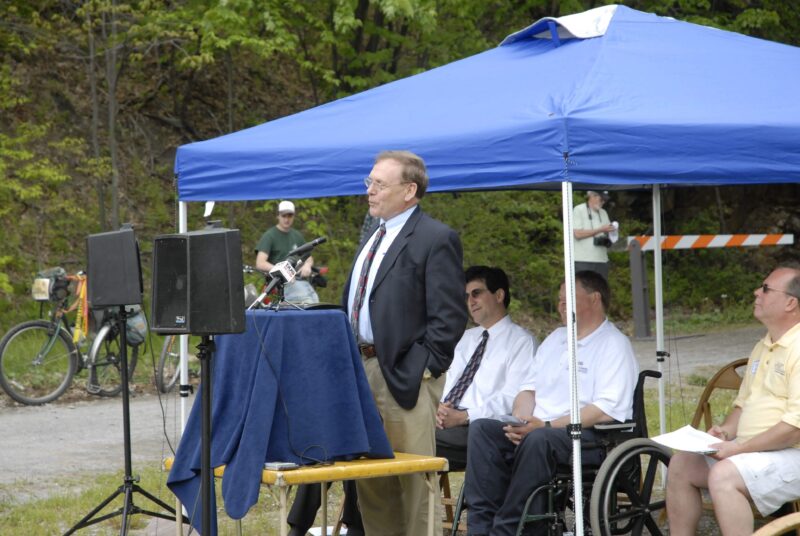
Congressman Rick Geist, Big Savage Tunnel dedication, 2006.
improved the quality of community life in the region. With the encouragement of her father, Alex G. McKenna, she joined the boards of several nonprofits, which taught her how to raise and use funds, not just distribute them, as well as how nonprofits functioned and how to manage large projects. Serving on these boards also expanded her network of contacts in philanthropy and large corporations.
God doesn’t give many people the tools that she had in her toolbox.
~Representative Rick Geist, transcript p. 13
In the mid-1980s Boxx merged all of her planning skills, fundraising experience, and local connections to build the Loyalhanna Creekside Trail in Latrobe. It was her work on this trail that brought Boxx into the orbit of the RTC. In her they recognized someone who was well connected to philanthropic and environmental leaders, familiar with the challenges of trailbuilding, and skilled at bringing diverse stakeholders to the table in pursuit of a goal.[1]
I think people like Linda Boxx are to be celebrated. Linda had, first of all, the resources at the time. But she also had more than that, a deep love of nature. … I think behind every great success story, there’s a lot of people. But, there’s generally this one spark, this one catalyst that keeps all those people together. And, those are leaders.
~ Larry Schweiger transcript p.30
In addition to Boxx, at the same time RTC brought Jim Linaberger onto the board. Jim had recently retired as Assistant to the President of People’s Natural Gas, where one of his responsibilities was to direct the company’s contribution budget. Boxx and Linaberger were charged with raising private money, and according to Linaberger, “very quickly, I think Linda and I realized that the best thing we could do for the Regional Trail Corporation would be to use our entrees into these foundations and corporate-giving people and bring them out to the trail for site visits instead of just sending a proposal at them.”[2] That strategy got donors excited about trails, but they continued to express confusion and frustration about the multiple trail groups requesting funding for the project.
In February of 1995, Michael Watson of the Richard King Mellon Foundation convened representatives from The Pittsburgh and Hillman Foundations and the Heinz Endowments. Boxx, along with Sias and Teeter, attended to make the case for the trail. As Teeter recalls, “they said, ‘You’d have to come together. You can’t give us five plans. Give us one plan. … We’ll give you a lot bigger money than what you have been getting.’”[1]
Linda, she was the biggest part of it. She knew how to pull people into the same room and get them to talk, even if they didn’t believe, just to listen.
~ Karen Post, transcript p. 11
Boxx took the meeting as “basically … a mandate to get organized” and so in the following months she reached out to Jeremy Muller who was with the Steel Industry Heritage Corporation and charged with building the Steel Heritage Trail (as it was called then), and John Stephens, who was executive director of the Friends of the Riverfront, just to meet them and say, ‘Okay, if we’re going to pull this together and look at things at least as a corridor… let’s see how we work together.’” In the midst of this process, Boxx found out that Dave Mankamyer, a Somerset County Commissioner, was planning the Somerset County Trail Summit and inviting all the partners from Pittsburgh to Cumberland to participate and talk about their trail projects. Boxx recognized, however, that the real goal of the summit was “how to solve Somerset County’s problems,” because they had all the expensive, large structures that needed to be rehabilitated. She believed so strongly in the mandate to pull trail stakeholders together that she and Sandra Finley “invited themselves” to a summit planning meeting held at the Lost Pelican restaurant and pitched a new plan:
the “Pittsburgh to Cumberland Trail Summit, hosted by Somerset County – that [looked] at broader issues … everybody’s issues, and not just Somerset County’s issues.”[2] On September 29, 1995, seven trail groups (and National Park Service Representatives from the C&O Canal) met at Hidden Valley Resort and agreed to join together in an alliance that they initially called the “Spine-Line Trail Association.”[3]
But, there was a lady come in there, a young- I call her a young girl or young lady, but she seemed very knowledgeable and she was very eager and I said, “Can you help us?” “Oh, yes,” she said. She’s Linda Boxx. And I said, “Well, this has to be a good spot.” And we made her more or less the Chairman.
~ Dave Mankamyer, June 2005, video interview by Paul g Wiegman p. 11
The Allegheny Trail Alliance (ATA) was formally incorporated in February of 1996.[4] One of the first projects that the ATA took on was the creation of a Master Implementation Plan that laid out the engineering, maintenance, historical interpretation, fundraising, and marketing vision for the trail. Boxx worked with Sandra Finley of Teeter Associates throughout 1996 to complete the plan, which by the time it was finished in early 1997 was barely contained within the rings of a three-inch binder. The key chapter contained the cost estimates for construction, which Mackin Engineering had been hired to complete. Private foundations, now able to see the vision for the trail, began awarding money for its construction.[1]
By that point, Boxx had moved on to securing federal and state funding as well. The Big Savage tunnel was the wild card in terms of cost. In April, 1997 she and fellow ATA board member Rick Malmstrom went to Harrisburg to meet with DCNR Secretary John Oliver. He directed them to immediately meet with Representative Rick Geist from Altoona, who chaired the House Transportation Committee and was an avid cyclist. They got a meeting with Geist that afternoon, and within 15 minutes, had secured two lines into State Capital budget: $6 million for the Big Savage Tunnel and $10 million for construction of the “C&O Canal Trail Extension.” The bill passed with $16 million included within DCNR’s allocation.
The elation of thinking they had secured trail building money was sobered upon the realization that these funds had to be released by the Governor; the authority to receive this money through the legislation did not guarantee that the Governor would allocate it for expenditure. Again, Secretary Oliver provided the strong advice: hire someone to help you get the money released!
By December 1997, ATA engaged Delta Development Group, a consulting firm based in the Harrisburg area that specialized in community planning and government funding strategies. They quickly put together a public funding strategy, which included the release of the capital budget funds. More importantly, they worked with the ATA to secure a line item in the federal Transportation Enhancement Act for the 21st Century (TEA-21), which passed in June of 1998. A $6 million High Priority Project allocation, with a subsequent $4.3 million awarded through the Pennsylvania Transportation Enhancements Advisory Committee (PA TEAC, chaired by Rep. Geist), pushed ATA’s fundraising into the stratosphere. Linda often called this the “Golden Age of Trailbuilding” and she knew that this window of time would be short lived requiring swift and decisive action.
“Linda gives credit to everyone for building this trail. But we know she made it happen. As a volunteer!”
~ Malcolm Sias, GAP History meeting October 2018
With funding in place, the Big Savage Tunnel was the next huge obstacle to tackle. Since funding was coming through DCNR, the state was technically the owner of the improvements and worked through Somerset County to allow this. Every time costs increased for the tunnel, Boxx was charged with going back to Governor Tom Ridge and his staff to make the case for more money to be released. By 2003, and nearly $12 million later, the tunnel was completed and Boxx could now set her sights on the final stretch into Pittsburgh.
You just have to be very dogged; that is one thing that Linda McKenna Boxx is so good at. She just simply does not take “no” for an answer, and if she gets “no,” then we figure out a different way. Getting “no” does not mean that the trail is not going to happen, it just means, “Oh, okay, we have to figure out something different then.” What’s a different way; pull out a different tool from our toolbox. And, I saw that happen time and again especially on the development of the Steel Valley Trail section.
~ Hannah Hardy transcript p.8
Boxx credits “good luck, miracles and secret weapons” for the success of the last nine miles into Pittsburgh—or the Gaps in the GAP, as the campaign was named. The Allegheny Conference on Community Development was spearheading a regional commemoration of the 250th anniversary of the founding of Pittsburgh and had named the completion of the Great Allegheny Passage as one of three legacy projects. This brought the attention of key corporate and county leaders, without which the project could not have succeeded.
“Getting from McKeesport to the Point challenged us all. Linda will tell you that the stars aligned to make it happen—she aligned those stars!”
Jack Paulik, Gaps in the GAP project manager, GAP History meeting October 2018.
In 2009 Linda McKenna Boxx was awarded the Pennsylvania Environmental Council’s Lifetime Achievement Award for her efforts in building the Great Allegheny Passage.
Jack Paulik, with whom Boxx had worked since her Latrobe trailbuilding years, offered his services to manage construction of the very difficult last nine miles. Acquisition of 28 properties, two aerial easements, refurbishing a historic bridge, placing two pre-fabricated bridges over active railroads tracks (in two hours) and transferring deeds are just a few of the challenges involved in closing the last “Gaps in the GAP.” Though the ACCD had hoped for completion by October 2008, that expectation proved to be unrealistic and the trail was finally finished in 2013.
The Point Made! celebration was held in Pittsburgh on June 15, 2013.
“Many people use the word “visionary” when describing my role; that is not correct. The “vision” for a trail connecting Pittsburgh to D.C. likely started with the Western Maryland Railway executives during abandonment. “Vision” was carried forward by Josh Whetzel and the Western PA Conservancy; actualized by the crafty work of Ohiopyle superintendent Larry Adams. My role, my self-mandate, was to finish the trail. I developed a procedural vision, how to gather up the separate trail-building efforts and hauled them over the finish line.”
~ Linda Boxx, November 2020
Linda Boxx’s 2006 Video Interview with Paul g Wiegman
Linda Boxx’s 2006 Video Interview Transcript with Paul g Wiegman
Linda Boxx’s 2019 Part I Interview Transcript with Avigail Oren
Linda Boxx’s 2019 Part II Interview Transcript with Avigail Oren and Susan Wiedel
Author: Avigail Oren
Endnotes
[1] Amy Kapp, “30 Years: Birth and Evolution of the American Rail-Trail Movement,” https://www.railstotrails.org/trailblog/2016/march/10/30-years-birth-and-evolution-of-the-american-rail-trail-movement/; Ellen Schwepe, “Legacy of a Landmark: ISTEA after 10 Years,” https://www.fhwa.dot.gov/publications/publicroads/01novdec/legacy.cfm.
[2] “Railbanking,” https://www.railstotrails.org/build-trails/trail-building-toolbox/acquisition/railbanking/.
[i] Teeter transcript pp 4-5
[ii] Sias transcript pp 14-6
[1] Linda transcript p 5
[1] Boxx transcript pp 4-13
[2] Linaberger transcript p 8
[1] Teeter transcript p 7; See also Sias transcript 16-7.
[2] Boxx transcript 19-20.
[3] Boxx transcript 19-22; Wiegman binder 74-5.
[4] Several meetings of the Spine-Line Association were held between October 1995 and February 1996.
[1] Teeter transcript 7-8; Wiegman binder 78.
[1] Teeter transcript pp 4-5
[1] Sias transcript pp 14-6

